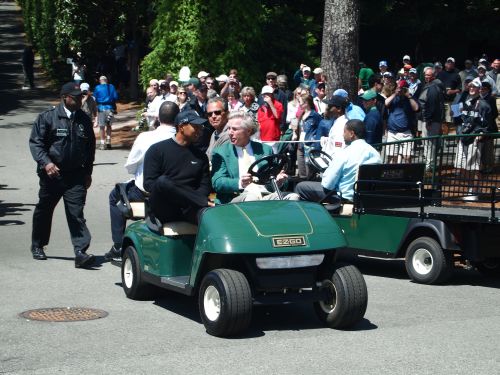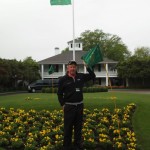With the start of the 2011 Masters now just a day away we look back 10 years when a new phase was thrust onto the golf world – ‘Tiger Slam’.
Tiger Woods went into the 2001 Masters having torn his rivals to shreds in capturing the last three Majors of the Millennium.
Then with seeming inevitability, Woods rolled over the Masters field to complete an unprecedented feat in the long history of golf – holding all four Major titles at the one time.
It was argued Woods won his second Masters because David Duval missed a five-foot birdie putt on the 72nd hole.
Woods was leading by one stroke at 15-under par, as he walked to his ball just off the 17th green as Duval was reading his five-footer up on 18.
“I didn’t know how short it was until someone told me later,” Woods was reported as saying.
“I knew he (Duval) had stiffed it on 18 because of the roar, but when I didn’t hear another roar, I knew he had missed it.”
But to say the final round of the 2001 Masters came down to Duval missing a birdie putt would be akin to declaring World War 11 last three days.
The 2001 Masters had began and ended with a clash of the generations.
There was double Augusta champion Bryon Nelson hitting the ceremonial drive on Thursday morning.
There were the 1967 champion Gay Brewer and 1957 winner Doug Ford competing in their last Masters.
But overall there was Woods winning a sixth Major and the fourth in succession.
No sooner had Woods defeated Bob May in a three hole play-off nine months earlier to capture the 2000 U.S. PGA Championship, and talk started of Woods completing the Grand Slam at Augusta.
There was the argument that Woods will have won four Majors in row over two calendar years.
Arnold Palmer stated: “It (Grand Slam) definitely has to be in the same year. But then what the hell, it will be a great accomplishment to win four in a row.
“But the ticker-tape comes when you win four in one year.”
It had been Palmer was coined the term ‘Grand Slam’ after capturing the first two Majors of 1960.
Augusta National designer Bobby Jones had won a ‘Grand Slam’, and earned himself the first of ticker-tape parades down the streets of New York in 1930 by winning the U.S. and British Open along with the U.S. Amateur and British Amateur titles.
However the closest any player had come to winning a professional ‘Grand Slam’ was Ben Hogan in capturing the 1953 Masters by five strokes, the U.S. Open at Oakmont by six strokes and his first and only British Open held that year at Carnoustie by four strokes.
Hogan had been robbed of completing the ‘Grand Slam’ because in electing to contest the British Open, the begun on Thursday July 9th, 1953, he had to miss the U.S. PGA that year at the Birmingham Club that had ended on Tuesday July 7th.
So Woods went into the 2001 Masters with the chance to do what no man had done before, winning four Majors in a row.
“If I win the Masters, I will consider it the Grand Slam since I’ll own all four major titles consecutively,” Woods said ahead of the Masters.
“So the way I look at it, if I win all four, I will all four, regardless what the calendar says. I know some people will disagree.”
Talk of a Tiger Slam went Woods off as a close to even money, a bet that looked safe when he opened with a 70, and then two strokes off the lead heading to the weekend after a day two 66.
It had been the same scores Woods shot in winning by an incredible 12 strokes four years earlier.
But instead of savaging the field as he had done on his pro debut in 1997, Woods found himself in the pack with a dozen of the world’s top-15 players at that time all under par.
There was Phil Mickelson tied with Woods on 136 along with Duval while double U.S. Open winner Ernie Els was at 139 and defending Augusta champion Vijay Singh at 140.
Woods arrived at the 13th tee that Saturday afternoon three strokes behind Angel Cabrera but less than an hour later he was in front by two.
After bogeying the 12th, Woods produced one of those trademark displays with three birdies in succession.
Woods with a 68 ended the round on 12-under par and one clear of Mickelson (69) with Mark Calcavecchia (68) and Chris DiMarco (72) at 10-under par.
Australia’s Stuart Appleby grabbed a slice of history that day in going 50 holes without a bogey, breaking Hogan’s record of 43 in 1947.
Appleby bogeyed the fourth hole in the first round and completed the remainder of the round and the next two without dropping a shot.
Unfortunately, Appleby’s streak ended at the first hole on Sunday on route to an eventual share of 31st place, and 16 shots behind Woods.
In the end, Woods carded a last day 68 to win by two with Duval (67) second and Mickelson, who played alongside Woods, letting slip the chance to become the first player in Masters history to record four rounds in the 60s in posting a 70 to be third on 270.
Mickelson would have to wait another three years before winning his first Major.
Unlike 1997, Woods didn’t destroy field and if anything he did what Mickelson suggested and that was to ‘just do what is required’.
“If I had of made at run at him, he (Woods) may have just followed suit,” Mickelson added.
That’s what made Woods unstoppable for the final three Majors of 2000 and the first Major of 2001.
His competitors just didn’t know how to deal with this, and whether they should fool themselves into thinking they really are in the mix or whether they should simply throw in the towel.
Vijay Singh fitted Woods with the green jacket, but the official photographers wanted more, and the Fijian obliged in actually fitted the jacket to Woods on a number of occasions.
Maybe the photographers knew something those looking on didn’t.
What we did learn was that the jacket fitted to Woods was the item of apparel Nick Faldo had fitted to him four years earlier but in contrast to 1997, on this occasion the jacket looked snug on the Ameican.
Woods delightedly remarked: “It still fits”.
Woods didn’t get a ticker-tape parade down Times Square but newspapers and sports magazines around the globe heralded the achievement.
“The Master’ proclaimed Golf World magazine on the cover of its April 13th, 2001 edition.
Aside from its name, Sports Illustrated had just one other word on the cover of its April 16th edition – ‘Masterpiece’ while the banner headline in the UKs Telegraph the morning after his victory was ‘Woods in world of his own”.
His agents, IMG also wasted little time in lining-up a photo shoot of Woods standing astride five of the greatest trophies in golf – the Masters clubhouse trophy, the U.S. Open trophy, the famed Claret Jug, the Rodman Wanamaker trophy, and the gleaming gold U.S. Amateur trophy
Among the many tributes to Woods, there was probably none more respectful than that of those emanating from the officials at Augusta National.
Mindful of the club’s history and their long controversial ‘no-blacks’ policy, Championship Committee Chairman, Billy Payne said: “Tiger you have made history today at Augusta. We are proud that it was here. We are even prouder of you and proud, as well, that you are a second-time Masters champion.”
But as we await the start of the 2011 Masters we can’t help but remarking how times have changed.
Woods is now ranked No. 7 in the world but then who would right him off capturing a fifth green jacket?
Bernie McGuire at Augusta, National





